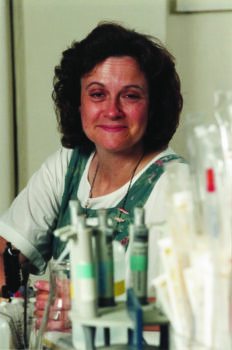Paula Lutz, who earned a bachelor’s degree in chemistry with a life science preference from UMR in 1976, and then served as a faculty member, associate dean of arts and sciences, department chair, and dean of arts and sciences, discusses adjusting to a campus which had few female faculty members.
Audio transcript

Everyone, and I think part of it was because I was a known quantity. I mean the chemists, most of the older chemists knew me from my time there and treated me well. Of course, Stig (Friberg), Nord (Gale) and Jim (Hufham) and that bunch, they treated me very well and not like . . . I guess it might have been if you come home and they kind of treat you like the kid sister or something. They treated me like a, you know, a full-fledged faculty member and bragged that they got their top choice and so they really made me feel welcome. The weird thing I do remember, Larry, in my first year, or two, or three . . . of course, we had quite a few women in biology by this time, and word spread, you know, that there were women in departments. There were starting to be a handful of women in engineering. And I would get a young woman on my doorstep that I didn’t know. And she would say, “My roommate had you for general biology and I have a question that I need to ask basically another woman.” And I’d say “Okay.” She said “What do I wear for my interview? You know, nobody is giving me any advice.” I mean these would be women with engineering experience. They were being told things that they weren’t sure were correct about how ultra conservative to be in their dress and, you know, things like that and I tried to be . . . you know, I say “well, you probably need to pay attention to what they tell you, but you probably can get away with a dress and a jacket. You don’t need to buy a suit”, right. I mean these were the kinds of things that I think women worry about and there really weren’t any women role models in the whole building. So that was, that was kind of an interesting thing. Well actually through Kappa Delta, there were a couple of other women on campus in engineering who had been Kappa Delta’s other places, and I got acquainted with them. And there were women in arts and sciences, just not so much on the science side. But I’d say women in the humanities and social sciences and the arts and sciences were very, were very welcoming to me. Liz Cummins, you know, great, just a great person. Catherine Riordon. I remember Catherine in psychology. She was very warm and welcoming. Sara Preston, actually in physical education. We crossed paths in a number of ways – children the same age, and I remember being on several committees with her. So, yeah, they were, they were very warm and welcoming, but we were a pretty select small group.
Share This Story
Spark a Memory?
Share your story! Fill out the form below to share your fondest memory or anecdote of S&T. If you'd prefer not typing, you can also share by phone at 833-646-3715 (833-Miner150).
Kathy (Stone) and Bob Phillips
Kathy (Stone) and Bob Phillips were both living in TJ Hall’s North Tower when they met in August 1986 while…
Katherine (Reid) and Josh Warner
Katherine (Reid) met Josh Warner in February 2011 at a social event co-hosted by her service sorority, Delta Omicron Lambda,…
Abby (LaPreze) and Jeremy Morris
When Abby (LaPreze) and Jeremy Morris first met as members of the 2007 Chancellor’s Leadership Academy (CLA), they didn’t realize…
Surveying the future of mining
Karl F. Hasselmann, who graduated in 1925 with a degree in mining engineering, was oil prospecting in Europe when he…
A civil war fortress
As the Civil War raged on, the Union Army, following a defeat at Wilson’s Creek in southwest Missouri, fell back…
Tina (Pankey) and Patrick Hammond
Tina (Pankey) and Patrick Hammond met through mutual friends at a party in November 2004. The couple had their first…